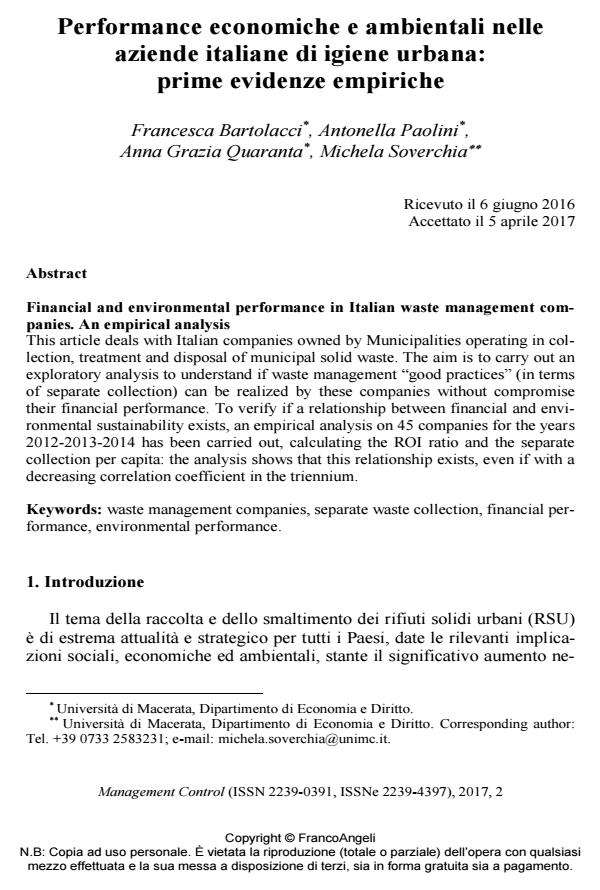Financial and environmental performance in Italian waste management companies. An empirical analysis
Journal title MANAGEMENT CONTROL
Author/s Francesca Bartolacci, Antonella Paolini, Anna Grazia Quaranta, Michela Soverchia
Publishing Year 2017 Issue 2017/2
Language Italian Pages 19 P. 33-51 File size 556 KB
DOI 10.3280/MACO2017-002003
DOI is like a bar code for intellectual property: to have more infomation
click here
Below, you can see the article first page
If you want to buy this article in PDF format, you can do it, following the instructions to buy download credits

FrancoAngeli is member of Publishers International Linking Association, Inc (PILA), a not-for-profit association which run the CrossRef service enabling links to and from online scholarly content.
This article deals with Italian companies owned by Municipalities operating in col-lection, treatment and disposal of municipal solid waste. The aim is to carry out an exploratory analysis to understand if waste management "good practices" (in terms of separate collection) can be realized by these companies without compromise their financial performance. To verify if a relationship between financial and environmental sustainability exists, an empirical analysis on 45 companies for the years 2012-2013-2014 has been carried out, calculating the ROI ratio and the separate collection per capita: the analysis shows that this relationship exists, even if with a decreasing correlation coefficient in the triennium.
Keywords: Waste management companies, separate waste collection, financial performance, environmental performance.
- Impatto della crisi economica su redditività e rischio finanziario delle imprese romagnole. Una cluster analysis Stefania Vignini, Tiziana De Cristofaro, in MANAGEMENT CONTROL 3/2018 pp.157
DOI: 10.3280/MACO2018-003008 - Diversità di genere e performance organizzativa: un'analisi empirica nel settore sanitario Valeria Naciti, Guido Noto, Carlo Vermiglio, in MECOSAN 120/2022 pp.45
DOI: 10.3280/MESA2021-120004 - Full costing nelle aziende di igiene ambientale: un caso di studio Francesca Bartolacci, Iacopo Cavallini, Michela Soverchia, in MANAGEMENT CONTROL 1/2019 pp.123
DOI: 10.3280/MACO2019-001006
Francesca Bartolacci, Antonella Paolini, Anna Grazia Quaranta, Michela Soverchia, Performance economiche e ambientali nelle aziende italiane di igiene urbana: prime evidenze empiriche in "MANAGEMENT CONTROL" 2/2017, pp 33-51, DOI: 10.3280/MACO2017-002003